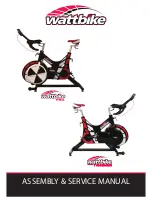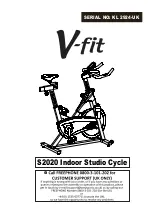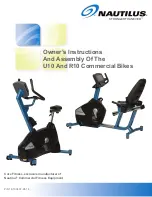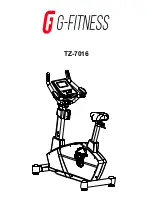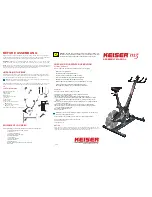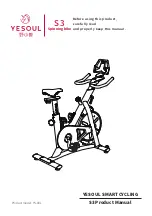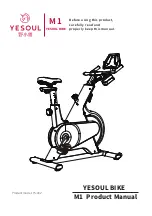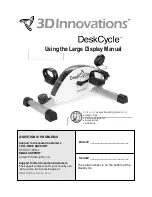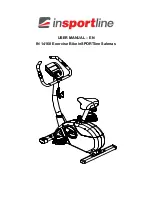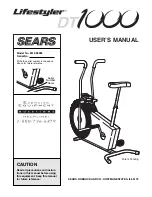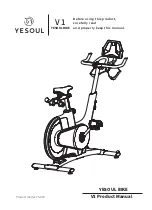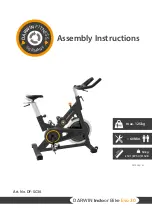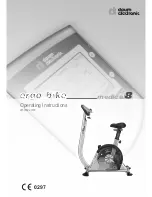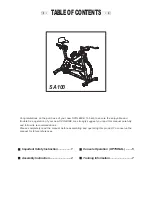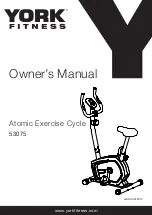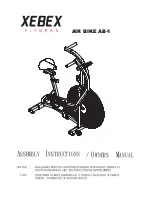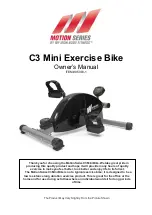
6
We reserve the right to carry out preliminary assembly work at the Wattbike factory. The Wattbike and all its components are
subject to constant, innovative quality assurance. We reserve the right to perform technical modifications.
Please keep the Wattbike original packaging so that it can be used, if necessary to transport the Wattbike at a later date.
Always store packing material in a way that will not cause any danger. Keep plastic bags away from children.
3. Wattbike Set Up
The correct set up is crucial to maximise performance, prevent injury and ensure the most comfortable riding on your Wattbike.
The correct sequence for set up is, saddle height, horizontal saddle position, handlebar height and horizontal handlebar position.
Before starting, ensure that your saddle is horizontal, use a spirit level if necessary.
3.1 Saddle Height
The easiest way to get a rough height for the saddle height is to stand the rider next to the bike with
the heel pushed into the back stabiliser, and then lift the saddle up so that the top of the saddle is
level with the boney protrusion of the hip.
Sit the rider on the Wattbike and align the crank arms with the seat post, place the heel of the foot on
the crank arm nearest the floor – the leg should be straight (but not locked out).
When clipped in (or with feet in the toe clips) and with the pedal at its longest stroke (inline with the
seat post) there should approximately 25-30 degrees bend on the knee. The rider should be able to
‘drop the ankle’.
Raise/lower the saddle height to get the correct leg position.
ALWAYS DISMOUNT THE WATTBIKE BEFORE MAKING
ADJUSTMENTS TO THE SADDLE.
Now get the rider to pedal backwards, they should be able to complete rotations with only a slight rocking of hips and without
the legs locking out.
3.2 Saddle Horizontal Position
With the feet clipped in (or in the toe clips) bring the crank arms parallel to the floor, drop a plumb line from the inside of the
knee, in the indentation next to the patella - it should bisect the pedal spindle. Adjust the saddle fore/aft to ensure that the knee
is over the pedal spindle.
NOTE – if you need to move the saddle fore/aft severely, you may need to raise/lower the saddle to compensate
The difference between the forward and back positions of the saddle fore/aft adjustment is 6 cm
3.3 Handlebar Height (saddle to handlebar difference)
Adjust the handlebar height so that it is no more than 4 to 10 cm lower than the saddle height
(depending on fitness and flexibility, a higher handlebar height may be more comfortable) – for
general exercise classes the saddle and handlebars should be at the same height - Use a long spirit
level from the saddle across to the handlebar to set this height.
Once the handlebar height has been set, check it by asking the rider to lift their hands off the
handlebars – they should be able to hold position.
NOTE – with the saddle and handlebar both set at maximum height there is a saddle to handlebar
difference of 7 cm – for safety reasons do not go above minimum markings – extra long stems are
available which increase the settings by 10 cm.
3.4 Handlebar Horizontal Position
Ask your participant to place their hands on top of the handlebars and bring the crank arms parallel
to the floor – drop a plumb line from the elbow, it should fall through the inside of the knee, in the
indentation next to the patella and should bisect the pedal spindle – adjust handlebars fore/aft to get
the correct position.
ALWAYS DISMOUNT THE WATTBIKE BEFORE MAKING ADJUSTMENTS TO THE
SADDLE OR HANDLEBARS.
An alternative method is to look at the angle of the back which should be at 45° parallel to the floor with
an upper arm to torso angle of 90°.
The difference between the forward and back positions of the handlebar fore/aft adjustment is 6 cm.
By following these simple steps the rider will be placed in the optimum position for both comfort and
effective cycling technique. Any slight variation in correct set up will alter the alignment of the joints,
muscles and subsequently technique. Ensure that you follow these simple steps with every new rider
and recap where required with your existing, regular riders.
25-30°
Summary of Contents for Pro
Page 1: ...ASSEMBLY SERVICE MANUAL...

